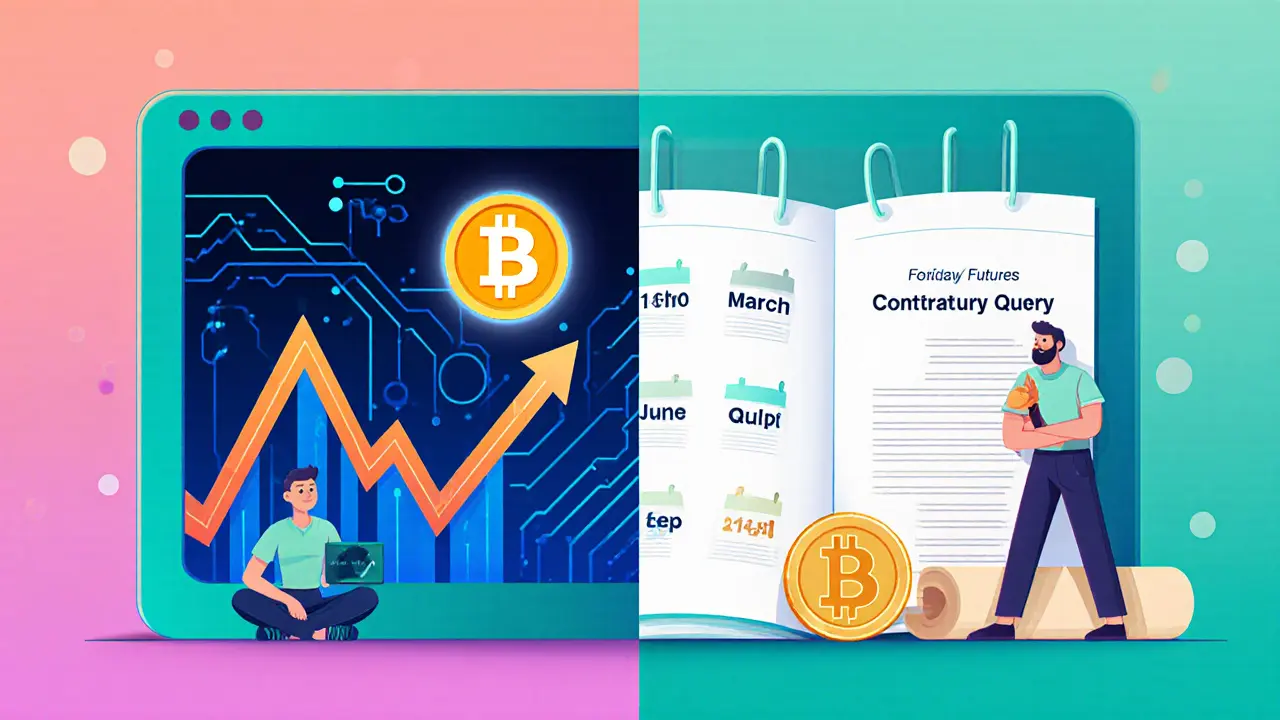Funding Cost Calculator
Calculate Your Funding Fees
Input your trading parameters to see how much funding fees will cost you over time. Compare against quarterly futures which have no funding fees.
Traders constantly ask whether to keep a position open forever or to roll it over every few months. The answer hinges on the nuances between perpetual futures vs quarterly futures. Both let you bet on crypto price moves without owning the coin, but they differ in expiration, funding, leverage, and risk handling. Below we break down everything you need to know, so you can pick the right contract for your strategy.
What Are Perpetual Futures?
Perpetual Futures are derivative contracts that never expire. As long as you maintain the required margin, you can hold the position indefinitely. The model was popularized by crypto exchanges because the market runs 24/7, giving traders uninterrupted access. To keep the contract price aligned with the spot market, a funding rate is exchanged between long and short positions every eight hours. If you’re long and the funding rate is positive, you pay a fee to shorts; if it’s negative, you receive a payment.
Because there’s no set expiration, you never need to worry about contract rollovers. However, the recurring funding fee can add up, especially for long‑term holders. Perpetual contracts usually settle in stablecoins like USDT, which means your profit or loss is realized in a quote currency rather than the underlying crypto.
What Are Quarterly Futures?
Quarterly Futures are contracts that expire on a fixed schedule - typically the last Friday of March, June, September, and December. The contract’s lifespan is exactly three months from issuance, after which it settles either in cash or in the underlying asset (often Bitcoin). For example, a BTC 0925 quarterly contract expires on September 25, 2025.
The biggest advantage is the absence of funding fees. Instead, traders pay a one‑time margin requirement and the exchange handles the settlement at expiry. Quarterly contracts often use USD pairs rather than USDT, and settlement may be in the base cryptocurrency, giving direct exposure to the asset.
Structural Differences
- Expiration: Perpetual - none; Quarterly - every three months.
- Funding Mechanism: Perpetual - periodic funding fee (every 8 hours); Quarterly - no funding fee.
- Settlement Currency: Perpetual - usually stablecoins (USDT, USDC); Quarterly - often the underlying crypto (BTC, ETH) or USD.
- Rollover Requirement: Perpetual - none; Quarterly - you must close, roll, or settle before expiry.
Cost Comparison
Costs dictate which contract suits a given horizon. Perpetual futures incur two main expenses: the funding fee and the borrowing cost embedded in the margin. Funding rates fluctuate with market sentiment; during bull markets longs typically pay, while in bear markets shorts pay. Over weeks or months these fees can erode a modest profit.
Quarterly futures eliminate the funding fee, making them cheaper for traders who plan to hold positions for weeks or months. However, you still face transaction fees (maker/taker) and a potentially higher initial margin requirement. The net cost difference becomes stark when you compare a three‑month hold: a perpetual position might pay 0.03 % per funding interval (≈0.27 % per day), whereas a quarterly contract pays only the exchange fee once.

Leverage & Margin
Both contract types allow leverage, but perpetual futures often offer higher ratios - sometimes up to 125× on major exchanges. Higher leverage magnifies gains and losses, demanding vigilant margin monitoring. Quarterly futures usually cap leverage lower (e.g., 10×-20×), resulting in larger capital outlay but reduced liquidation risk.
Because perpetual contracts require continuous margin checks every eight hours, a rapid price swing can trigger liquidation sooner than with a quarterly contract that only settles at expiry. Traders who prefer lower risk exposure often gravitate toward quarterly contracts, especially institutional players with stricter capital allocation rules.
Liquidity & Market Participation
Liquidity tends to be split. Perpetual futures dominate day‑trading volume; their 24/7 nature attracts scalpers, day traders, and algorithmic strategies. Quarterly futures, with standardized expiration dates, attract institutional investors, hedgers, and arbitrageurs who value predictable settlement dates and deeper order books on each expiry cycle.
In practice, you’ll see tighter bid‑ask spreads on perpetual contracts during high‑volatility periods, while quarterly contracts often have more consistent depth across the three‑month window. This makes quarterly contracts preferable for large‑size trades that could otherwise move the market.
Risk Management & Rollover Strategies
Managing risk differs sharply. With perpetual futures, the primary active decision is monitoring the funding rate and ensuring you have enough margin to avoid liquidation. You can leave the position open indefinitely, but you must be ready for sudden funding spikes.
Quarterly futures force a decision before expiry: close the position, roll into the next quarter, or let it settle. Rolling involves closing the near‑term contract and opening a new one, often with a “calendar spread” that can be structured to capture the term structure of funding rates. This forced checkpoint can be a discipline advantage, prompting traders to reassess exposure regularly.

Choosing the Right Contract for Your Strategy
Here’s a quick decision matrix:
- Short‑term speculation (minutes to days): Perpetual futures - no expiry, high leverage, instant funding adjustments.
- Medium‑term position (weeks to a few months) with cost sensitivity: Quarterly futures - no funding fee, lower leverage, predictable settlement.
- Hedging a physical or spot holding: Quarterly futures - settlement in the underlying crypto lets you lock in future price.
- Institutional capital with strict risk controls: Quarterly futures - regulated margin, deeper liquidity, no surprise funding.
Ultimately, the choice hinges on how you value funding costs versus the convenience of an endless contract.
Quick Comparison Table
| Feature | Perpetual Futures | Quarterly Futures |
|---|---|---|
| Expiration | No expiration date | Fixed every 3 months |
| Funding Fee | Paid/received every 8 hours | None |
| Typical Settlement | Stablecoin (USDT/USDC) | Underlying crypto (BTC, ETH) or USD |
| Leverage Range | Up to 125× (varies by exchange) | Typically 10-20× |
| Margin Call Frequency | Every 8 hours (funding) | Only at expiry |
| Liquidity Profile | High short‑term, 24/7 | Deep quarterly order books, less volatile |
| Ideal Users | Day traders, scalpers, algo bots | Institutional, hedgers, long‑term position traders |
Common Pitfalls & Pro Tips
- Pitfall: Ignoring funding rates on perpetual contracts. Tip: Monitor the funding tracker; adjust position size when rates spike.
- Pitfall: Forgetting to roll a quarterly contract before expiry. Tip: Set calendar reminders 24 hours before the last trading day.
- Pitfall: Over‑leveraging on perpetual futures. Tip: Use no more than 5× leverage for volatile assets unless you have a tight stop‑loss.
- Pitfall: Assuming settlement currency is always stablecoin. Tip: Verify each contract’s settlement terms; quarterly contracts may settle in BTC, affecting tax treatment.
Frequently Asked Questions
What is the main advantage of perpetual futures?
They let you stay in a position indefinitely without worrying about expiry dates, which is perfect for short‑term trading and algo strategies.
Do quarterly futures have funding fees?
No. Quarterly contracts replace the funding mechanism with a single margin requirement and settle only at expiration.
Can I roll a perpetual contract into a quarterly one?
Yes. Traders often close the perpetual position and open a quarterly contract to lock in a longer horizon while avoiding funding fees.
Which contract type is better for institutional hedging?
Quarterly futures are generally preferred because they provide a predictable settlement date, deeper liquidity, and no ongoing funding cost, aligning with risk‑management frameworks.
How does leverage differ between the two contracts?
Perpetual futures often allow very high leverage (up to 125× on some platforms), while quarterly futures typically cap at 10-20×, reducing liquidation risk.

20 Comments
Lena Novikova
Perpetuals are just a tax scam disguised as trading. Every 8 hours you're paying some algorithm for the 'privilege' of holding. Why not just buy the actual coin and HODL? No fees, no drama. This whole funding rate thing is a casino gimmick.
Olav Hans-Ols
Honestly both have their place. I use quarterly for anything over a week - no surprise fees and I can sleep at night. Perpetuals? Yeah I use 'em for quick scalps but I keep it under 5x leverage. Life’s too short to watch funding rates like a hawk 😅
Kevin Johnston
Perpetuals = freedom 🚀 Quarterly = discipline 💪
Dr. Monica Ellis-Blied
It is critically important to recognize that the structural asymmetry between perpetual and quarterly futures reflects a fundamental misalignment in risk architecture - particularly when leverage is applied without adequate margin buffers. The funding mechanism, while mathematically elegant, incentivizes speculative behavior that is fundamentally incompatible with prudent capital preservation.
Moreover, the normalization of 125x leverage on perpetual contracts is not merely reckless - it is an institutional failure of risk governance. Exchanges that permit such exposure are not facilitating trading; they are facilitating systemic fragility.
Quarterly contracts, by contrast, impose natural discipline: expiration forces accountability. This is not a limitation - it is a safeguard. Institutions use them not because they are ‘conservative,’ but because they are rigorously designed to align with fiduciary duty.
When you ignore funding rates, you are not ‘trading’ - you are gambling with borrowed capital. And in a market where liquidity evaporates in seconds, that is not a strategy - it is a suicide pact.
There is no such thing as ‘free’ leverage. There is only deferred risk - and it always comes due.
Herbert Ruiz
Perpetuals are just for noobs. Everyone who knows anything uses quarterly.
Saurav Deshpande
Ever wonder why funding rates always go positive during bull runs? Coincidence? Or is it a hidden tax to fund the exchange’s buyback program? They make you pay to hold while they quietly accumulate BTC on the quiet. The system is rigged - you're the liquidity pump, they're the silent whale.
Paul Lyman
Yo I just started trading last month and I didn't even know about funding rates till I got liquidated 😅 Now I only do quarterly - no more sleepless nights. Also, I think I spelled ‘funding’ wrong in my notes… whoops.
Frech Patz
Could you clarify the tax implications of settlement in BTC versus USDT for quarterly contracts? Specifically, does settlement in the underlying asset trigger a taxable event in the U.S. under IRS guidelines, even if the position is not closed?
Derajanique Mckinney
why do ppl even use quarterly?? perpetuals are way easier 😴
Rosanna Gulisano
If you're holding past a week you're already doing it wrong
Sheetal Tolambe
I love how this post breaks it down so clearly! I’ve been using quarterly for my long-term positions and it’s been so much calmer. No stress about funding rates at all. Feels more like investing than gambling. Thanks for the clarity 🙏
gurmukh bhambra
They’re watching you. Every funding payment, every rollover - it’s all tracked. The Fed, the exchanges, the algos - they know when you’re long. They manipulate the rate to squeeze you. Don’t trust the system. Go off-chain. Use BTC in your wallet. This is all a trap.
Sunny Kashyap
Perpetuals are for Americans. In India we use only quarterly. Less risk. More real.
james mason
How quaint. I only trade perpetuals on Binance with 100x leverage - and I’ve been doing it since 2017. You wouldn’t understand the elegance of it. Most people can’t handle the psychological depth required. It’s not for the faint of heart - or the uneducated.
Anna Mitchell
I’ve been using quarterly for my BTC hedge and it’s been perfect. No surprises, just clean execution. Really appreciate the breakdown - helpful!
Pranav Shimpi
Biggest mistake I made? Holding perpetuals through a funding spike in Dec 2023. Lost 30% in 48 hrs. Now I only use quarterly for anything over 7 days. Also, leverage above 10x is just a fancy way to say ‘I want to lose money.’
And yeah, settlement in BTC is way better for tax purposes - you avoid the USDT wash trade nonsense. But make sure you track your cost basis properly. I use Koinly, but I typoed my wallet address once… took me 3 weeks to fix. Don’t be me.
Also, if you’re using 125x leverage - please, for the love of Satoshi, just stop. You’re not a trader. You’re a lottery ticket.
Quarterly contracts give you breathing room. You get to think. You get to sleep. You get to live. Perpetuals are a treadmill. One wrong funding rate and you’re gone.
And if you think ‘I’ll just roll’ - you’re lying to yourself. Rolling costs money. Slippage. Fees. And you’re still paying funding on the new one. It’s a trap. Don’t fall for it.
Bottom line: if you’re not an algo bot or a market maker, stick to quarterly. Your future self will thank you.
jummy santh
As a trader from Nigeria, I find this comparison extremely valuable. In our market, where volatility is extreme and access to stablecoins is inconsistent, quarterly futures offer a rare anchor of predictability. The absence of funding fees is not merely an advantage - it is a lifeline for those who cannot afford to lose capital to algorithmic arbitrage.
Moreover, settlement in the underlying asset allows us to directly integrate our trading gains into our local economy - converting BTC to Naira via peer-to-peer platforms with minimal friction. This is not just financial engineering; it is economic empowerment.
I urge all traders, especially those in emerging markets, to consider the cultural and infrastructural context when choosing contract types. What works in New York may not sustain a trader in Lagos. The discipline of quarterly expiration is not a constraint - it is a protection against the predatory structures of global finance.
Thank you for this thoughtful, grounded analysis. It resonates deeply with our reality.
Kirsten McCallum
Anyone who uses perpetuals is just chasing dopamine. Real traders plan. Real traders expire.
Henry Gómez Lascarro
You people are missing the entire point. Perpetual futures were designed by Wall Street to extract wealth from retail traders through invisible, compounding fees - the funding rate is a disguised interest charge, disguised as a market mechanism. And quarterly contracts? They’re just a slower version of the same scam, designed to make you think you’re safe while they manipulate the expiry price to trigger liquidations on the last Friday of the quarter. It’s not about funding - it’s about control.
Every time you think you’re ‘hedging’ or ‘investing,’ you’re just feeding the machine. The exchanges don’t care if you win or lose - they profit from volume, from fees, from liquidations. They don’t care if you sleep at night - they care if you refresh your screen every eight hours.
And don’t even get me started on the ‘institutional preference’ for quarterly contracts. Institutions use them because they’re allowed to - not because they’re better. The same institutions that pushed 100x leverage on perpetuals now pretend quarterly is ‘safer’ - because they’ve already extracted your money, and now they want to look responsible to their regulators.
The real answer? Don’t trade derivatives at all. Own the asset. Hold it in your wallet. Don’t let a centralized exchange dictate your exposure. The entire system is a casino built on debt, leverage, and psychological manipulation. And you’re still here, debating which seat to take.
Stop playing their game. Or at least - stop pretending you’re not already losing.
Lena Novikova
And that's why I just bought BTC on Coinbase and HODL. No fees. No drama. No exchange can touch it. You're all still playing their game.